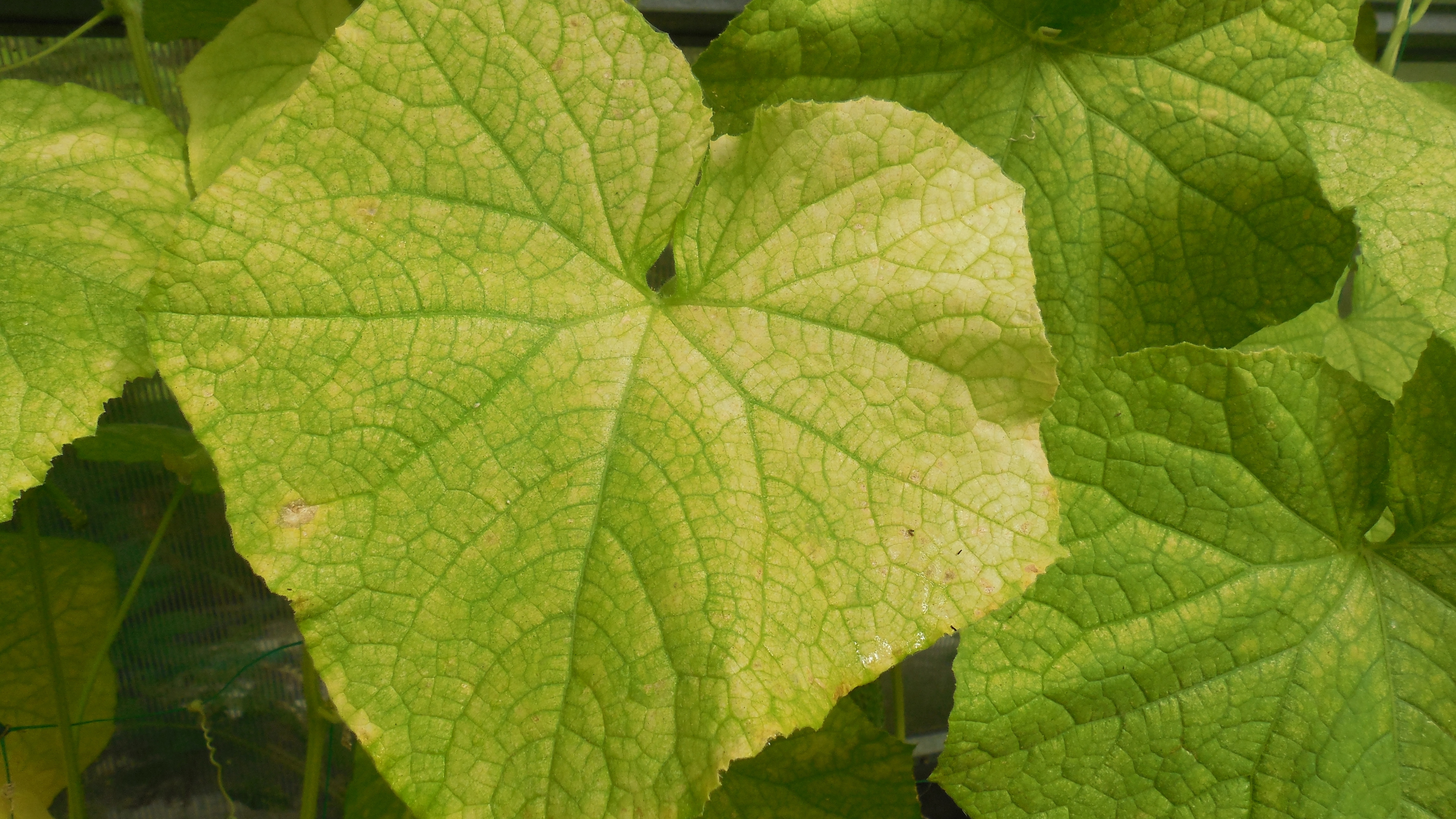Cucumber Green Mottle Mosaic Virus and Watermelon Green Mottle Mosaic Virus

Cucumber green mottle mosaic virus (CGMMV) and watermelon green mottle mosaic virus (WGMMV) can cause severe disease and significant economic losses in cucurbit species such as pumpkins, watermelons, and zucchinis.
These viruses can be transmitted through seed. They spread easily when healthy plants come into contact with contaminated equipment, hands, clothing, or plant material. CGMMV was first discovered in the United Kingdom in the 1930s. It was reported in North America in 2013. WGMMV was first described in 2019 from a 2007 detection in Taiwan and reported in North America the same year. These viruses are under official control in the United States.
CGMMV and WGMMV can be challenging to spot. Symptoms may not appear until 6 weeks after seed sowing and may fade as plants mature. Some infected plants may appear normal.
Look for:
- Mottled leaves covered with uneven blotches or patches of different shades or colors, including white, yellow, brown, purple, red, and pink.
- Leaves with a mosaic pattern that contains even-shaped spots or streaks of yellow, white, and green.
- Fruit that appears mottled, discolored, malformed, and has spongy flesh.
Because CGMMV and WGMMV are seedborne pathogens, management should begin with the seed. Early detection and identification are critical to prevent introduction of these viruses.
- Use seed and transplants from reputable sources. Make sure that seed is tested and declared free of CGMMV and WGMMV. Inspect all transplants for symptoms before planting.
- For transplant production, monitor seedlings regularly and test any suspected to be infected with CGMMV/WGMMV. If either one or both viruses are detected, destroy all plants within 3 to 5 feet of the symptomatic seedlings to prevent the virus from spreading further.
- During grafting operations, follow strict sanitation practices for all work surfaces and tools and put in place hygiene worker training programs that include sanitation of boots, clothing, hands, and tools. The most effective disinfectants are sodium hypochlorite (0.53% solution) and glutaraldehyde (0.22%). Commercially available products such as Clorox® (Clorox Company, Oakland, CA) or Virocid® (CID Lines N.V., Belgium) can be used as stock to prepare a working solution.
- Keep records of seed and transplant sources so they can be traced if needed.
- Disinfect all agricultural machinery and equipment before moving between fields and farms.
- To prevent contamination from visitors and their vehicles, limit access to a secure place near the entrance to the farm; this site should have cleaning and disinfection facilities.
- Eliminate potential CGMMV/WGMMV reservoirs, such as volunteer plants and alternate host weeds, particularly any weeds in the cucurbit family.
- Minimize crop handling and other procedures that may wound the plants, especially early in the growing season, as the most severe yield losses result from early infections.
- Scout plants in the field for symptoms of CGMMV/WGMMV infection; take tissue samples and have diagnostic testing done on suspect plants. Train field workers and fruit pickers to report any unusual looking plants or fruit.
- Follow a crop rotation strategy with 2 to 3 years between cucurbitaceous crops.
Host Removal
All infected plant material must be removed using APHIS-approved disposal methods. Cut, rake, and burn all plant material in infected fields. If burning is not an option, disking fields is an acceptable alternative.
To prevent infection of new host material, infested field(s) should remain free of CGMMV/WGMMV hosts for at least 2 years. During this time, aggressive weed control is necessary to prevent volunteer cucurbit and broadleaf weed growth. Equipment or personnel entering fields must follow strict sanitation protocols to reduce the likelihood of spreading CGMMV/WGMMV. Fields should be tested for the presence of CGMMV/WGMMV before they are returned to cucurbit production. This can be done by using sentinel plants (susceptible hosts) throughout the fields during the non-host crop or fallow period.
Equipment Disinfection
- Equipment must be power washed or steam cleaned to remove all soil and debris before it leaves infested areas.
- Saturate all surfaces with an appropriate disinfection solution.
- Surfaces must be exposed to the disinfectant for at least 15 minutes before rinsing.
- Each disinfectant should be prepared daily from the stock according to manufacturer instructions or EPA label.
- Approved disinfection chemistries include:
| Disinfectant (active ingredient)* | Application rate |
|---|---|
| Sodium hypochlorite [NaOCl] | 0.53% |
| Glutaraldehyde [OHC(CH2)3CHO, C5H8O2] | 0.22% |
*Commercially available products such as Clorox® (Clorox Company, Oakland, CA) or Virocid® CID Lines N.V., Belgium) can be used as stock to prepare a working solution.
Seed Treatment
The only way to eliminate CGMMV and WGMMV from infected seed is to destroy the seed.
Report Plant Pests and Diseases
Have you seen this pest or signs of pest damage? Immediately report your findings.
Find your State plant regulatory official
Find your State plant health director

